|
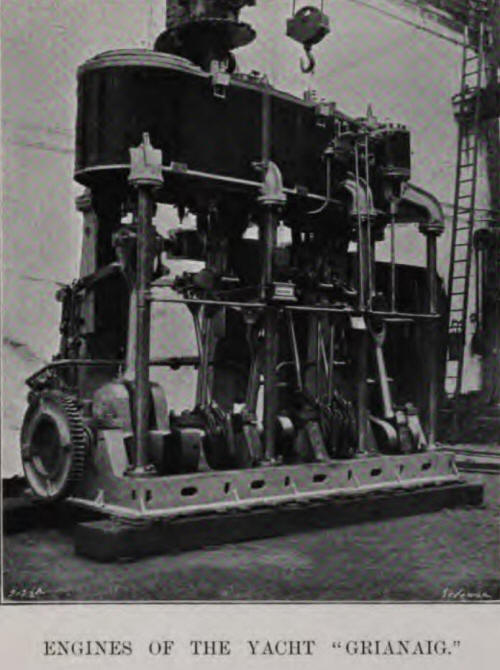
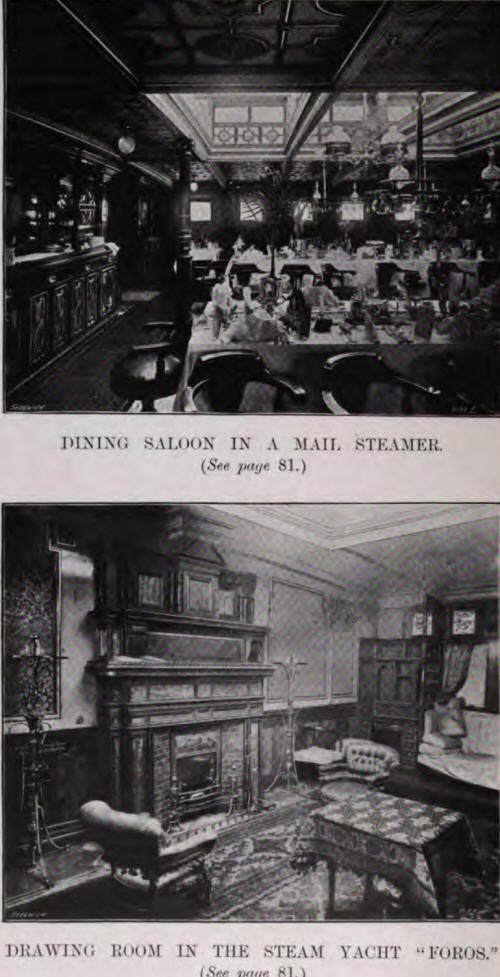
PROPHECY has its allurements even in the domain of applied mechanics; and
having reviewed progress during the past two centuries in naval
architecture, as embodied in sailing ships, merchant steamers, warships,
and yachts, there is a temptation to speculate on the prospects of the
future. The possibilities of the steam turbine, for manufacturing which
the Scotts are laying down a special plant; the potentialities of the
producer-gas engine as applied to the propulsion of ships; and even the
solution of the problems which stand in the way of the application of the
universally-desired oil turbine, are all topics which would prove
interesting, even although no conclusion could be arrived at. It is
enough, however, to say here, that each is having careful consideration by
the firm.
The historian is not, however, concerned with the future, and the only
justification for the title given above is the intention here to briefly
review the state of marine construction, as represented at the beginning
of this new century by typical vessels built or being built by the Scotts.
It is difficult, where so many ships of distinctive design and equipment
have been constructed, to select a few representative types. Amongst the
countries which have had new ships in recent years are France, Russia,
Italy, Denmark, Holland, Portugal, Greece, India, the Straits Settlements,
China, Australia, New Zealand, Brazil and other South American Republics,
and the United States of America. This list of foreign clientele, however,
is being diminished, owing to the influence of subsidies paid by foreign
Governments to shipowners or shipbuilders.
Taking account only of large vessels built during the past fifty years,
there are one hundred and five of Scotts" steamers now trading in China
seas, twenty-six in the Indian Ocean, ten on the north Atlantic, nine in
the South African seas, thirty in South American waters, eighteen in the
Colonial service, and ninety-seven on the European coast; while in home
waters there are many more.
One of the gratifying features in connection with the commercial
relationship of the Scotts, too, is the continuance of .confidence over a
long period of years of several of our large steamship companies. This is,
perhaps, the best indication of the satisfactory character of the work
done. The Holt Line have had built for them within forty years, by the
Scotts, forty-eight vessels of 148,353 tons. The China Navigation Company
have had a greater number of ships, namely, sixty-four, but as the size is
smaller the total tonnage is less, namely, 115,600 tons. An important
Continental firm has had twenty-one vessels; while for a Portuguese
Company five large vessels were built, and for the French Trans-Atlantic
Company eleven fast liners. Other cases might be mentioned, but these
suffice.
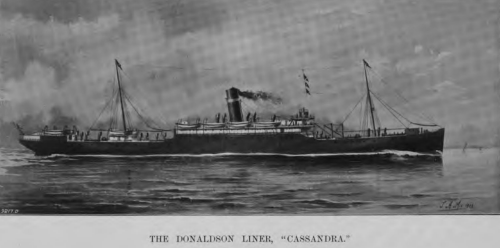
As regards fast, steamers the recent warships built and described in a
previous chapter may be accepted as typical in so far as the problems of
marine engineering are concerned. In each of these cases the design of the
machinery has been prepared by the firm, and the difficulties were more
complicated than in the case of merchant work. Moreover, it must be
remembered, that the maritime predominance of Britain is due as much to
that enormous fleet of moderate-speed intermediate and cargo ships, which
maintain exceptionally long voyages with regularity and economy, as to the
fast ships engaged on comparatively short routes. Of the nine thousand odd
British ships included in Lloyds' Register, less than 24 per cent. have a
speed of over 16 knots: a fact which in itself proves that economy, rather
than speed, is the primary consideration.
The new Donaldson liner, now being constructed by the firm, may be
accepted as representative of one of the most useful types of steamer in
the British fleet. An illustration of this vessel is given on Plate
XXVIII., facing page 74. While primarily intended for the Atlantic
passenger trade, she is of such moderate dimensions as to suit almost any
service, having a length of 455 ft. between perpendiculars, a breadth of
53 ft., and a depth, moulded, of 32 ft.; the draught will not be more than
26 ft. with a displacement of 13,500 tons. While designed to carry 8000
tons of deadweight cargo in the four holds, the vessel has accommodation
for a large number of passengers, who are afforded more room than on the
larger and faster liners, with the same luxury and comfort. This latter
fact accounts in large measure for the growing preference of a great
proportion of the travelling public for the intermediate ship.
The
machinery has been designed with the view of attaining the highest
economy. For driving the twin screws there are two separate three -
cylinder triple - expansion engines, which are to indicate together 5500
horse-power when running at the moderate piston speed of 680 ft. per
minute. The cylinders are respectively 26 in., 42 in., and 70 in. in
diameter, the stroke being 48 in. There is a very complete installation of
auxiliary machinery. In all, there are fifty-seven steam cylinders in the
ship, each having its special function.
Steam for all of these is supplied at a pressure of 180 lb. per square
inch, by two double-ended boilers 20 ft. long, and two single-ended
boilers 11 ft. 6 in. long, the diameter in all cases being 15 ft. 9 in.
The total heating surface is about 15,000 square feet, and the grate area
435 square feet. In the design and construction of the engines and boilers
every consideration has been given to strength in order to ensure
reliability.
In dealing with the development of the steamship we had occasion to refer
to the Holt liners, which inaugurated the first regular steamship service
to the Far East, vid the Cape of Good Hope. That was in 1865, and since
then a long series of most successful steamships has been constructed by
the Scotts for the China trade of the Ocean Steamship Company. As
representative of the modern ship for this service we take four vessels
just completed, three of them taking the names of the pioneer ships of the
line葉he Achilles, Agamemnon, and Ajax, while the fourth is named
Deucalion; one of these is illustrated on Plate XXIX., facing this page.
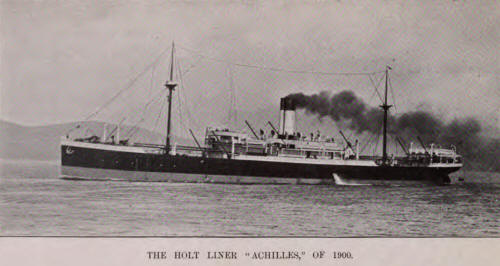
Throughout the forty years that have elapsed since the first vessels were
built, each successive steamer of the forty-eight built by the Scotts has
marked an increase in size, and an improvement in economy. in the former
respect the advance is not perhaps so striking as in some other trades ;
but it must always be remembered that a ship which is to steam for 12,000
or 13,000 miles without many opportunities of coaling cannot be of high
speed; otherwise the bunker capacity would be so great as to seriously
reduce the available cargo space; while the running expenses would be so
heavy as to materially decrease the utility of the vessel as an aid to the
development of commerce. There is ever the happy mean, which has here been
realised with characteristic prudence and enterprise.
The forty years' progress in the case of the Holt liners has brought about
an increase of 50 per cent. in the dimensions of the ship, the later
Scotts' vessels being 441 ft. between perpendiculars, 52 ft. 6 in. in
breadth, and 35 ft. in depth moulded, with a gross register of 7043 tons.
In respect of deadweight capacity, however, there has been considerable
development, due to the adoption of mild steel having permitted a
reduction in the weight of boilers and engines, and in the scantlings of
the hull. The new vessels, with a draught of 26 ft. 6 in., carry 8750 tons
of deadweight cargo葉wo and a-half times the weight carried by the
earliest bit liners.
In forty years the steam pressure in the bolt liners has increased from 60
lb. to 180 lb.; and the piston speed from 400 ft. to 720 ft. per minute.
The heating surface in the boilers has decreased from 6 square feet to 3
square feet per unit of power ; and the condenser surface from 1.83 square
feet to 1.3 square feet per unit of power. On the other hand, each square
foot of grate gives now 14 horsepower, as compared with 6.6 horse-power
formerly.
As a result of increased steam pressures and greater efficiency of
propulsion, it may be taken that, notwithstanding the increase in
dimensions and capacity of the ship, and the consequent advance in engine
power, the coal required for a voyage half way round the world has been
reduced to one half that of 1865.
Another notable feature in the economy of the ship is that twenty-five
derricks have been fitted for dealing rapidly with the cargo, and one of
these has a lifting capacity of 35 tons, to take such heavy units of cargo
as locomotive boilers and tenders. In addition, there are eighteen steam
winches. The reduction in the time spent in port, because of the
facilities thus provided, is another element in the economy of the modern
ship.
The largest oil steamer yet constructed, the Narragansett, was completed
by the Scotts in 1903. This vessel, built for the Anglo-American Oil
Company, carries in her sixteen separate compartments, 10,500 tons of oil,
at a speed of 11 knots, for a fuel consumption of 4.9 lb. of coal per 100
tons of cargo per mile. This result is deduced from steaming, in ordinary
service, over nearly 24,000 miles, and is consequently as reliable as it
is interesting.
The Narragansett, which is illustrated on Plate XXX., facing this page,
has a length between perpendiculars of 512 ft. and overall of 531 ft.; the
beam is 63 ft. 3 in., and the depth, moulded, 42 ft. The deadweight
carrying capacity on a draught of 27 ft. is 12,000 tons. The engines are
of the triple-expansion type. Interest in the machinery is associated
principally with that fitted for the pumping of the oil cargo. There are
two pump-rooms, one located conveniently for the oil in the eight
compartments forward of the machinery space; the other in a corresponding
situation for the same number of tanks abaft the propelling engines. The
10,500 tons of cargo can be loaded or discharged in less than twelve
hours. While primarily for the Atlantic trade, the vessel was designed to
undertake, if required, the much longer voyage of the Eastern service.
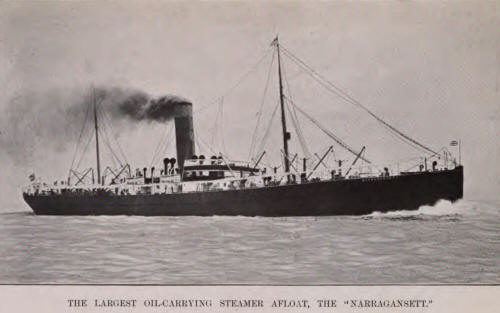
Because of the uniformly good results with ordinary coal, we give the
details as received from the superintending engineer of the owners:-
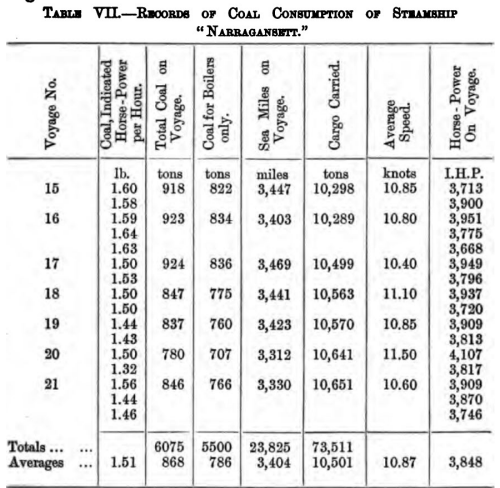
The China Navigation Company of London, for whom the Scotts began building
in 1875, have had in the thirty years sixty-four vessels, which have been
an important factor not only in the development of trade in China, but
also in the advancement of British interests in the Far East.
In an earlier Chapter we referred to the extent of the service conducted
by these vessels, and also to the Company's continuous progressive spirit,
which, for instance, induced them, on the suggestion of the Scotts, to
adopt twin..screws. The launch of one of these ships is illustrated on
Plate XXXI., facing this page, while the next Plate, XXXII., illustrates
the Fengtien, which was built in 1905 in an exceptionally short period of
time. The contract was made in the closing week of 1904, the first
keel-plate was laid on the 15th January, 1905, the vessel was launched on
the 20th April, and arrived in Shanghai on the 14th July様ess than
twenty-six weeks from the date when the building was commenced. This
performance indicates not only the satisfactory character of the
organisation, but also of the equipment of the shipyard and marine
engineering works.
The Fengtien has a length between perpendiculars of 267 ft., a beam of 40
ft., and a depth, moulded, of 18 ft., with a deck-house having
accommodation for thirty-three European first-class passengers; while on
the top of this house there is, as shown in the engraving, a promenade for
passengers. The accommodation provided for first-class passengers is
exceptionally satisfactory, both in respect of state-rooms and of public
saloons. Fifty-six first-class Chinese passengers are also carried, as
well as seventy steerage native passengers. In addition to this
considerable source of revenue, the ship carries 1720 tons of deadweight
cargo on a draught of 14 ft.
The Fengtien on her trial, when developing 2146 horsepower, attained a
speed of 13* knots, which was considered highly satisfactory, in view of
the unusual dimensions. The engines are of the triple-expansion,
three-cylinder type, fitted with every accessory which experience has
shown to ensure regularity of working, with the minimum of expense in
respect of upkeep and working cost. Steam at 190-lb. pressure is supplied
by two boilers, 15 ft. in diameter and 11 ft. 6 in. long, having 5184
square feet of heating surface, and 121 square feet of grate area.
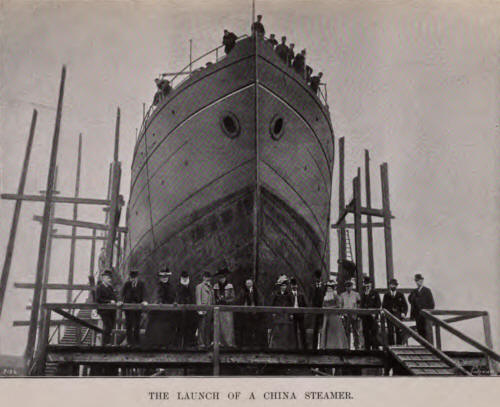
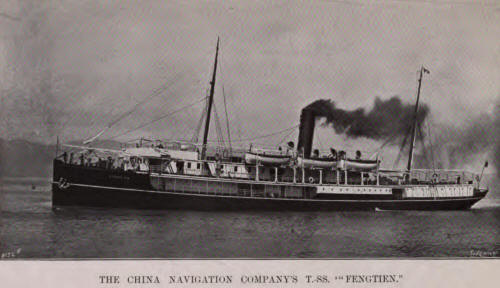
We have referred generally to the passenger accommodation in the ships
built by the firm, and it may be interesting to refer here to the
character of the work done and illustrated on Plate XXVII., facing page
73. The first view shows the dining-room of one of four Portuguese
steamers. This room is designed in the Jacobean style. The walls are
framed and panelled in solid walnut, and all the mouldings, cornices,
architraves, pilasters, columns, pediments, and also the furniture, are
beautifully carved. The floor is laid in mosaic tiles, in geometrical
patterns, with Brussels carpet runners in the passage-ways. The ceiling is
of yellow pine, moulded, ribbed, and broken up with carved panels, painted
a fiat white and relieved with gold. The dome skylight is in teak, with
richly-carved beams and mouldings; and glazed with embossed plate glass,
while the side windows are fitted with jalousie blinds, stout double-line
teak shutters, and glass bull's-eyes in brass frames. The upholstery is in
crimson Utrecht velvet, and seating accommodation is provided for
sixty-eight saloon passengers.
The other view on Plate XXVII. illustrates the drawing-room of the steam
yacht Foros, built for M. Kousenzoff, of Moscow. It is in the Elizabethan
style. The walls are framed in solid East Indian satinwood, highly
finished and French polished, with figured silk tapestry panels of a shade
that harmonises and blends with the wood-work. Neat and delicate carving
in low relief is introduced where most effective. The ceiling, of yellow
pine, has square panels of Tynecastle tapestry, relieved with rich carving
in cornices and beams. The room is lighted and ventilated by eight large
round lights in the ship's side, each enclosed in a recess with a sliding
screen of beautifully-stained and leaded glass. The large circular
skylight in the centre of the room, finished to suit the ceiling, has
large opening sashes, glazed with stained glass. The floor is laid with
oak parquetry, with a Parisian mat in the centre. The room is heated by a
slow-combustion grate with rich brass mounts, tiled hearth, fire-brasses
and fender. The mantelpiece and overmantel, in satinwood, is a beautiful
piece of work幼arved and relieved with colonnades and pilasters. This room
is fitted with a complete installation of electric bells and lights, with
two graceful electric candelabra, one on each side of the fireplace. The
stained glazing is illumined at nights by electric lights on the outside.
The drawing-room is completely and artistically furnished with high
mirrors, fitments, writing-tables, card and occasional tables, and with a
variety of beautifully upholstered chairs and sofas. All the metal-work is
of ormolu.
The British India Steam Navigation Company is another of the old clients
of the Scotts. This Company, originally formed in 1856, under the title of
the Calcutta and Burmah Steam Navigation Company, which was changed in
1862 to the title now known in all maritime countries, had its first
steamship built by the Scotts, and it is therefore interesting to
illustrate the one recently built at the same Works葉he Bharata. This
vessel is of the intermediate type, carrying a large number of British and
native passengers, and nearly 4000 tons of cargo. The length between
perpendiculars is 373 ft., the beam 45 ft., and the depth, moulded, 29 ft.
6 in. The cargo carried on a draught of 24 ft. is 3940 tons, and this is
handled by eight hydraulic cranes, some of them of high power. The
passenger accommodation, in the centre part of the ship, includes state
rooms and saloons for forty-two first-class and thirty-six second-class
European travellers, while in the 'tween decks a large number of native
passengers are accommodated.
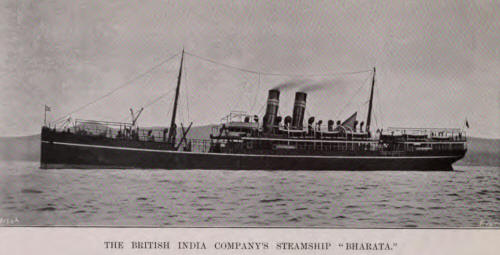
The machinery of the Bharata gives a speed of 16 knots, when the
displacement is 5560 tons. The engines are of the triple -expansion type,
and develop 6000 indicated horse - power. Five single - ended boilers
supply steam at 180 lb. pressure. This vessel in service carries her cargo
of about 4000 tons and her passengers at a speed of 16 knots, for a
consumption of ordinary coal of about 50 tons per day.
In our historical Chapters it has been clearly shown that the Scotts took
a prominent part in the evolution of Channel steamers, and reference may
be made to the latest vessels of this class now being built at the
Company's works葉wo steamers for the old and successful firm of G. and J.
Burns, Limited. These vessels, the dimensions of which are :有ength 233
ft., breadth 33 ft., depth 24 ft., are to have a speed of 13 knots. They
are to be employed on the service between Glasgow and Manchester, and are
fitted for steerage passengers, and also for conveying cattle, horses and
sheep. The machinery consists of three- cylinder triple-expansion engines
of 1750 indicated horsepower, having cylinders 23 in., 36 in., and 58 in.
in diameter respectively, with a stroke of 42 in. The boilers, of which
there are two in each ship, are 14 ft. in diameter and 12 ft. 6 in. in
length, with a heating surface of 4000 square feet, and a grate area of
120 square feet. They work under natural draught at a pressure of 175 lb.
per square inch.
We might continue almost indefinitely describing different types of ships,
but will content ourselves with a reference to the fleet of Thames
passenger steamers built in 1905 for the London County Council. Of the
thirty vessels constructed for the Council, twenty had their boilers and
engines from the Scotts' Works. Ten of the steamers, in which this
machinery was fitted, were built on the Clyde by Messrs. Napier and
Miller; six at Southampton, by Messrs. John I. Thornycroft and Company;
and four at Greenwich, by Messrs. G. Rennie and Company. These vessels are
130 ft. long, and of very light draught-2 ft. 10 in. when loaded. An idea
of their proportions is given by the engraving on Plate XXXIV.,facing this
page, showing one of the Clyde-built vessels ready to steam from Greenock
to London.
The engines for all of these vessels are of the compound,
diagonal, surface-condensing type, the two cylinders being 16 in. and 31
in. in diameter, with a stroke of 3 ft.
One set of engines is illustrated on Plate XXXV., adjoining page 85. They
have forged steel guide column R, to bind the cylinders to the three
entablature frames. The crank-shaft is a solid steel forging, 61 in. in
diameter, coupled to the steel paddle-shafts by flexible couplings. The
surface-condenser, cylindrical in form and constructed of light brass
sheets, is placed below the guide bars close to the cylinders. The
water-ends are of cast brass, arranged for double circulation of the
water. The air-pump, of the trunk type, is driven by bell-crank levers off
the low- pressure connecting-rod. Two independent feed-pumps are driven
oft the same crosshead.
The auxiliary machinery includes a circulating pump with auxiliary
air-pump attached, a direct-acting feed and bilge pump, a fan and engine
for the forced draught, and an electric engine and dynamo.
Each steamer has one cylindrical steam boiler, 9 ft. in diameter by 9 ft.
3 in. long. The working steam pressure is 110 lb. The boilers are also
illustrated on Plate XXXV. The twenty sets of engines and boilers were
completed in a remarkably short space of time.
These steamers were designed for a service speed of 12 statute miles per
hour, and a trial speed of 13 miles per hour, or 11.285 knots. The best
trial performances were attained by the FitzAilwin and the Turner, both
built on the Clyde; they attained a speed of 14.1 miles per hour, or 12*
knots, with the engines making 69.8 revolutions per minute, and indicating
360 horse-power. This is nearly 1 sea mile per hour more than was required
by the contract.
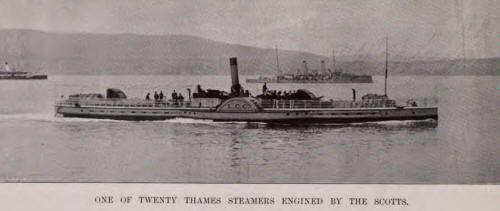
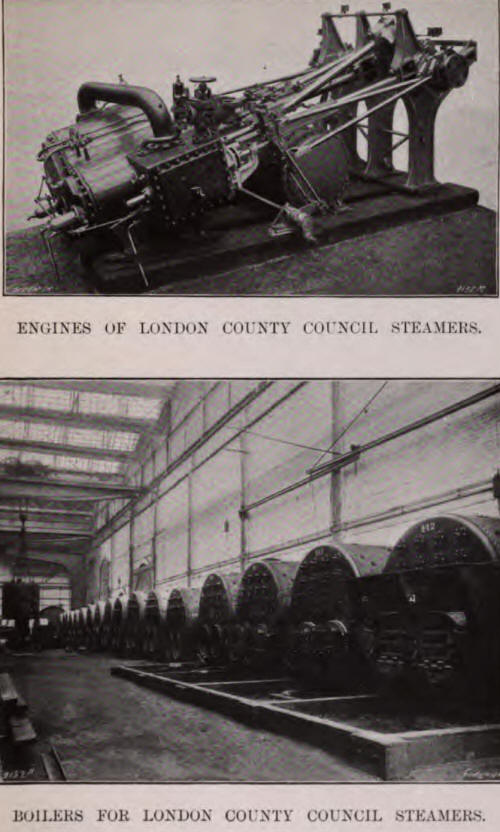
We illustrate on Plate XXXVI., facing page 86, a typical set of
triple-expansion engines. The practice in respect of the design of engines
and boilers is necessarily very varied. From the designs for a small steam
launch to those for a first-class cruiser or battleship there is a wide
range, and all classes of work, with not a few of special interest, come
between those extremes. In connection with the three-crank
triple-expansion engine, now generally adopted for merchant work, an
arrangement well favoured for sizes up to about 1000 indicated horsepower
is that in which the high-pressure cylinder is in the centre with a piston
valve, the intermediate-pressure cylinder being forward, and the
low-pressure cylinder aft, each with a slide valve at the extreme ends.
This has been found to give a handy arrangement of gear, and to be easily
accessible. With twin-screw engines of this power it is customary, and has
been found very convenient, to lead all the hand-gear for both engines to
a pedestal placed midway between the engines and ahead of the forward
cylinders.
A description of the types of engines built by the Scotts for the China
Navigation Company during the past thirty years would be practically a
history of the progress of marine engineering during that period. The
customary sequence of cylinders has in the main been adhered to in the
design of these engines要iz., high-pressure cylinder forward and
low-pressure cylinder aft in the case of compound engines: the
intermediate-pressure cylinder, in in the case of triple-expansion
machinery, is placed between the high- and low-pressure cylinders. Indeed,
this latter is the arrangement invariably adopted by the firm in the
design of all large-size ordinary cargo steamer engines. The valve gear is
forward of its cylinder in each case. This has also been the design
adopted in the case of recent high-class passenger and mail steamers with
three cylinders, and in the case also of steamers for special trades.
Twin-screw engines present little deviation from the above, and such as
there is mainly affects pipe connections.
All engines of whatever type
up to about 1000 indicated horse-power are usually arranged with forged
columns in front. The condenser is ordinarily designed to form part of the
engine structure, having the columns out on, and supporting the cylinders;
but not infrequently it is entirely separate from the main engines, and is
carried either on the back of the columns, or fitted in the wing of the
ship.
Of engines for the Navy nothing need be said beyond stating that they form
quite a class by themselves, and all present the special features of
design so characteristic of Admiralty work referred to in an earlier
Chapter. The latest types of large-size engines for the Admiralty are
being fitted with a system of forced lubrication to main bearings and
crank-pins.
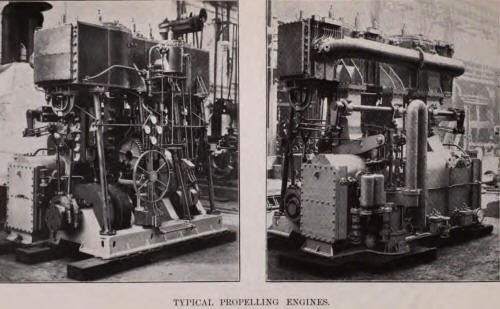
The Scotts' practice with respect to paddle engines has been no less
varied than that in the case of screw machinery, ranging as it does from
the ponderous side-lever engine of past years to the stern-wheel engine of
the shallow-draught steamers of the present day. Oscillating and diagonal
engines, both compound and triple-expansion, are also within the
experience of the Company, the three-stage expansion being the type now
usually adopted. With respect to auxiliary machinery, the Scotts
invariably fit a separate centrifugal pump for circulating the water
through the condenser for all classes of engines, excepting only those for
the ordinary tramp steamer. The air, bilge, and sanitary pumps are usually
worked from the main engine by levers. The feed pumps are generally
independent. Frequently, especially in yachts, all the pumps are entirely
independent of the main engines. The Scotts in some oases make all
auxiliary machinery for their own engines: such as centrifugal pumps,
fans, feed-heaters, auxiliary condensers, duplex feed and ballast pumps,
etc.
Many varieties and types of boilers have been made. The old practice of
having two or three rings in the length of the shell in ordinary
cylindrical boilers has long since given place to one plate in the length.
The boiler ends are seldom made in more than two plates; up to diameters
of 11 ft. only one plate is used. The number of riveted seams is thereby
reduced to a minimum, and the liability of the boiler to leak is minimised.
The Scotts also have a system of forced draught for supplying either cold
or heated air to the furnaces, which is fitted largely to their ships, and
gives every satisfaction. Large installations of Belleville and Yarrow
water-tube boilers for working under forced draught have also been made
and fitted in H.M. ships, but they need no description here. A large
installation for burning oil fuel has recently been completed and applied
by the firm to the Babcock and Wilcox water- tube, and the cylindrical,
boilers of H.M.S. Argyll.
|

